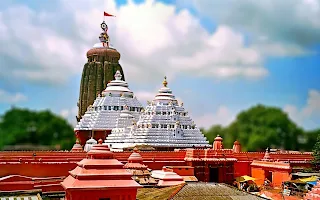Jagannath Temple - Puri, Odisha: A Spiritual Marvel
The Jagannath Temple, situated in the vibrant city of Puri in the state of Odisha, India, stands as a timeless testament to devotion, artistry, and the rich cultural heritage of the region. With its towering spires, intricate architecture, and profound religious significance, this temple has earned its place as one of India's most revered pilgrimage sites. Let's delve into the fascinating history, architecture, and spiritual aura that encompass the iconic Jagannath Temple.
A Glimpse into History
The history of the Jagannath Temple dates back over a thousand years. The temple is dedicated to Lord Jagannath, believed to be an incarnation of Lord Vishnu, and is a central hub of devotion for Hindus. While the exact origin of the temple is shrouded in the mists of time, it is commonly believed to have been built in the 12th century during the reign of King Anantavarman Chodaganga Deva of the Eastern Ganga dynasty.
Architectural Grandeur
The architecture of the Jagannath Temple is a harmonious blend of Kalinga (Odishan) style and Dravidian influences. The main temple structure is an impressive Kalinga-style deul (tower), characterized by its pyramid-like spires. These spires, known as vimanas, dominate the skyline of Puri and are adorned with intricate carvings depicting scenes from Hindu epics, mythological tales, and celestial beings.
The temple complex encompasses around 20 acres and includes several structures like the Singhadwara (Lion's Gate), Mukti Mandap, and the Nata Mandap. The Singhadwara is the main entrance and features colossal statues of lions on either side, symbolizing the protectors of the divine abode. The Nata Mandap, or the Festival Pavilion, is renowned for its 56 intricately carved pillars that depict various dance postures from classical dance forms.
The Spiritual Experience
The spiritual significance of the Jagannath Temple extends beyond its architectural magnificence. The temple is famous for its annual Rath Yatra, a grand procession during which the deities of Lord Jagannath, Lord Balabhadra, and Goddess Subhadra are taken out of the temple in elaborately decorated chariots. This event attracts millions of devotees and tourists from around the world, making it one of the largest religious gatherings.
Devotees believe that a glimpse of the deities or a partaking of the prasadam (blessed food offering) from the temple can bestow spiritual blessings and liberation. The temple's unique practice of serving Mahaprasad, the food offering to the deities, to everyone without any discrimination, regardless of caste or creed, emphasizes the principles of equality and devotion.
Preservation Efforts and Challenges
Over the centuries, the Jagannath Temple has faced its share of challenges, including invasions, natural disasters, and changes in rulership. Despite these trials, the temple has managed to retain its spiritual essence and cultural significance.
Efforts have been made to preserve the temple's heritage and architectural marvels. The Archaeological Survey of India has been actively involved in conserving the intricate sculptures and maintaining the structural integrity of the temple.
Conclusion
The Jagannath Temple in Puri, Odisha, is not merely a physical structure; it is a living embodiment of faith, artistry, and tradition. Its towering spires, intricate carvings, and spiritual significance continue to draw innumerable pilgrims and enthusiasts, fostering a sense of unity and devotion that transcends boundaries. As a symbol of India's rich cultural tapestry, the temple stands as a reminder of the enduring power of spirituality and human creativity.


